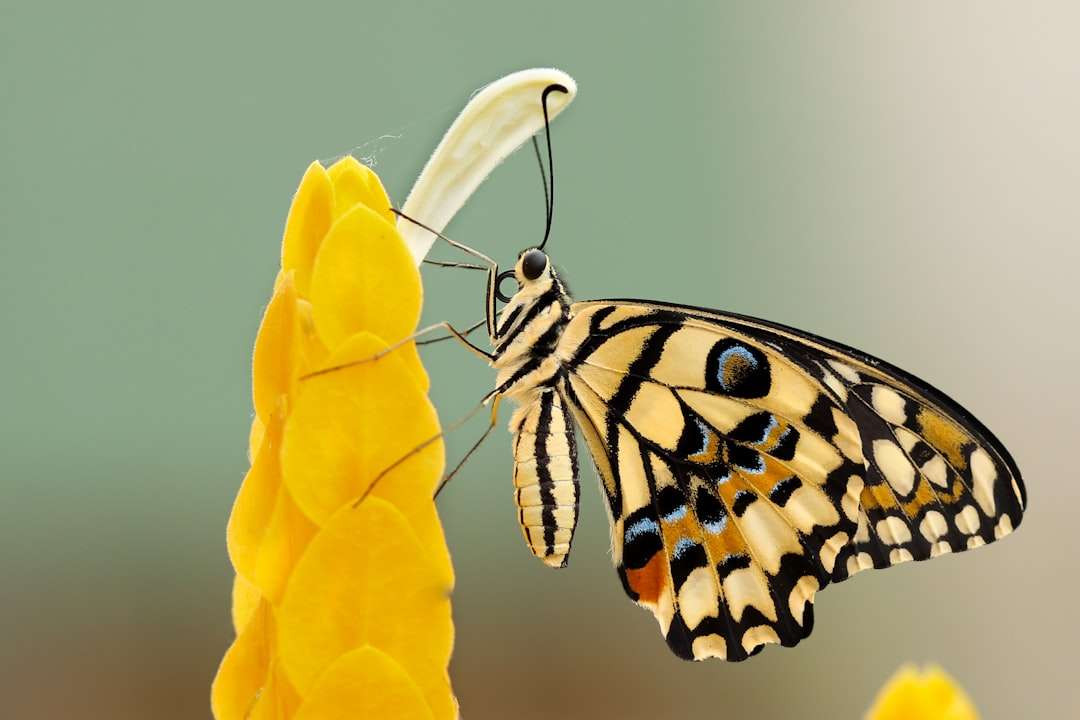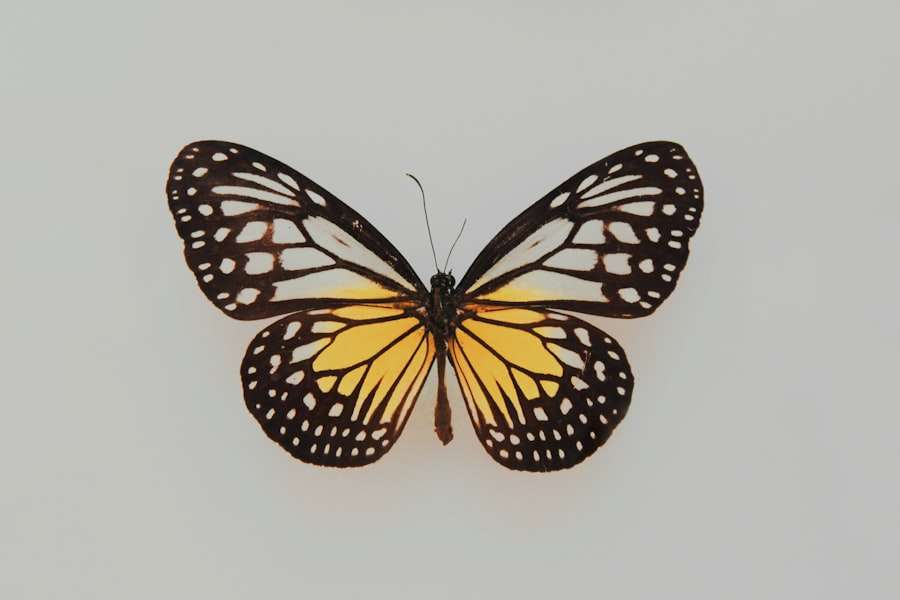The Metamorphosis of Dreams: Understanding the Symbolism of Butterflies

Butterflies are one of the most fascinating creatures in the natural world. With their vibrant colors and delicate wings, they captivate our attention and inspire awe. But beyond their beauty, butterflies play a crucial role in ecosystems and have deep cultural and symbolic significance. In this article, we will explore the world of butterflies, from their characteristics and habitats to their symbolism in different cultures and traditions. We will also delve into the science of metamorphosis, the symbolism of butterflies in literature and art, and the impact of small changes on the world. Furthermore, we will discuss the spiritual meaning of butterflies, their role in ecosystems, and their symbolism as a symbol of freedom and liberation. Finally, we will explore how butterflies can inspire change and transformation in people.
The Fascinating World of Butterflies: A Brief Introduction
Butterflies are insects belonging to the order Lepidoptera, which also includes moths. They are characterized by their large, often brightly colored wings and slender bodies. Butterflies have a unique life cycle that involves a process called metamorphosis, where they undergo a complete transformation from egg to caterpillar to pupa to adult butterfly.
There are thousands of species of butterflies found all over the world, each with its own unique characteristics and habitats. Some butterflies are found in tropical rainforests, while others thrive in meadows or deserts. They come in a wide variety of colors and patterns, ranging from vibrant blues and oranges to subtle shades of brown and gray.
The Significance of Butterflies in Different Cultures and Traditions
Butterflies hold great significance in many different cultures around the world. In some cultures, they are seen as symbols of beauty, grace, and transformation. For example, in Japanese culture, butterflies are associated with femininity and are often depicted in art and literature as symbols of love and beauty.
In Native American cultures, butterflies are seen as messengers from the spirit world. They are believed to bring messages of hope, transformation, and renewal. In some tribes, butterflies are also associated with the souls of deceased loved ones.
In Chinese culture, butterflies are symbols of joy and happiness. They are often depicted in art and literature as symbols of love and marital bliss. In Chinese folklore, it is believed that if a butterfly lands on you, it is a sign of good luck and prosperity.
The Science of Metamorphosis: How Butterflies Transform
| Stage | Description | Duration |
|---|---|---|
| Egg | The first stage of a butterfly’s life cycle. The egg is usually laid on a leaf or stem of a plant. | 4-10 days |
| Larva | The second stage of a butterfly’s life cycle. The larva, also known as a caterpillar, hatches from the egg and spends most of its time eating and growing. | 2-4 weeks |
| Pupa | The third stage of a butterfly’s life cycle. The pupa, also known as a chrysalis, is a protective casing where the caterpillar transforms into a butterfly. | 1-2 weeks |
| Adult | The final stage of a butterfly’s life cycle. The adult butterfly emerges from the pupa and is ready to mate and lay eggs. | 2-4 weeks |
The transformation of a butterfly from egg to adult is a truly remarkable process. It begins with the female butterfly laying eggs on a host plant, which will provide food for the caterpillar once it hatches. The eggs hatch into tiny caterpillars, which spend their time eating and growing.
As the caterpillar grows, it sheds its skin several times in a process called molting. Each time it molts, it reveals a new, larger skin underneath. Once the caterpillar has reached its full size, it forms a chrysalis or pupa, where it undergoes a complete transformation.
Inside the chrysalis, the caterpillar’s body breaks down into a soupy substance. This substance then reorganizes itself into the body of an adult butterfly. After a few weeks or months, depending on the species, the adult butterfly emerges from the chrysalis and begins its short but beautiful life.
The Symbolism of Butterflies in Literature and Art
Butterflies have long been a source of inspiration for artists and writers. In literature, butterflies are often used as symbols of transformation and rebirth. They represent the idea that change is possible and that we can emerge from difficult times stronger and more beautiful.
In art, butterflies are often depicted as symbols of beauty, freedom, and spirituality. They are often used to represent the fleeting nature of life and the impermanence of beauty. Artists use butterflies to convey a sense of lightness and joy, as well as a connection to the natural world.
The Butterfly Effect: Understanding the Impact of Small Changes

The butterfly effect is a concept in chaos theory that suggests that small changes can have large, unpredictable effects on complex systems. The term was coined by mathematician and meteorologist Edward Lorenz, who discovered that even tiny changes in initial conditions can lead to drastically different outcomes.
The butterfly effect is often used as a metaphor for the interconnectedness of all things and the idea that our actions, no matter how small, can have far-reaching consequences. It reminds us that even the smallest acts of kindness or the tiniest changes in behavior can make a big difference in the world.
From Caterpillar to Butterfly: A Journey of Self-Transformation
The transformation of a caterpillar into a butterfly is often seen as a metaphor for personal growth and self-transformation. Like the caterpillar, we go through periods of growth and change, shedding old beliefs and behaviors to make way for new ones.
The journey from caterpillar to butterfly is not an easy one. It requires patience, perseverance, and a willingness to let go of what no longer serves us. But in the end, it is worth it, as we emerge from our cocoons stronger, wiser, and more beautiful than ever before.
The Spiritual Meaning of Butterflies: A Symbol of Hope and Renewal
In many spiritual traditions, butterflies are seen as symbols of hope, renewal, and transformation. They are often associated with the soul’s journey and the idea that death is not an end but a transition to a higher state of being.
In some spiritual practices, butterflies are used as symbols of guidance and protection. They are believed to be messengers from the divine, bringing messages of love, healing, and spiritual growth.
The Role of Butterflies in Ecosystems: A Vital Connection
Butterflies play a crucial role in ecosystems as pollinators. As they feed on nectar from flowers, they inadvertently transfer pollen from one flower to another, allowing plants to reproduce. In fact, butterflies are second only to bees in their importance as pollinators.
Butterflies also serve as a food source for other animals, such as birds and bats. They are an essential part of the food chain and help maintain the balance of ecosystems.
The Butterfly as a Symbol of Freedom and Liberation
Butterflies are often seen as symbols of freedom and liberation. Their ability to fly and their vibrant colors represent the freedom to explore, to be oneself, and to break free from constraints.
Throughout history, butterflies have been used as symbols of liberation in social and political movements. For example, during the Civil Rights Movement in the United States, butterflies were used as symbols of freedom and equality.
The Power of Butterflies: Inspiring Change and Transformation in People
Butterflies have the power to inspire change and transformation in people. Their beauty and grace remind us of the beauty that exists in the world and the potential for growth and transformation within ourselves.
Butterflies can also serve as a reminder to slow down, appreciate the present moment, and embrace change. They teach us that change is a natural part of life and that it can lead to new opportunities and experiences.
In conclusion, butterflies are not just beautiful creatures; they are also important players in ecosystems and hold deep cultural and symbolic significance. They teach us about the power of transformation, the interconnectedness of all things, and the potential for growth and change within ourselves. Whether we see them as symbols of hope, freedom, or personal growth, butterflies have the power to inspire us and remind us of the beauty and wonder of the natural world.
If you’ve ever wondered about the symbolism behind seeing a butterfly in your dreams, you might find this article on dream symbolism fascinating. It explores the deeper meaning behind various dream symbols, including the butterfly. Understanding the significance of these symbols can provide valuable insights into our subconscious thoughts and emotions. To delve further into dream symbolism, check out this related article on what the moon symbolizes.
FAQs
What does it mean to dream about a butterfly?
Dreaming about a butterfly can symbolize transformation, change, and growth. It can also represent beauty, grace, and freedom.
What is the significance of the color of the butterfly in a dream?
The color of the butterfly in a dream can have different meanings. For example, a black butterfly can symbolize death or mourning, while a yellow butterfly can represent happiness and joy.
What does it mean to see a butterfly in a dream but not be able to catch it?
If you see a butterfly in your dream but are unable to catch it, it can symbolize missed opportunities or unfulfilled desires. It can also represent the fleeting nature of beauty and happiness.
What does it mean to see a butterfly in a dream and be able to catch it?
If you are able to catch a butterfly in your dream, it can symbolize success, achievement, and the ability to seize opportunities. It can also represent the attainment of beauty and happiness.
What does it mean to see a butterfly in a dream and have it land on you?
If a butterfly lands on you in your dream, it can symbolize a connection to nature, as well as a sense of peace and harmony. It can also represent a spiritual or emotional transformation.





